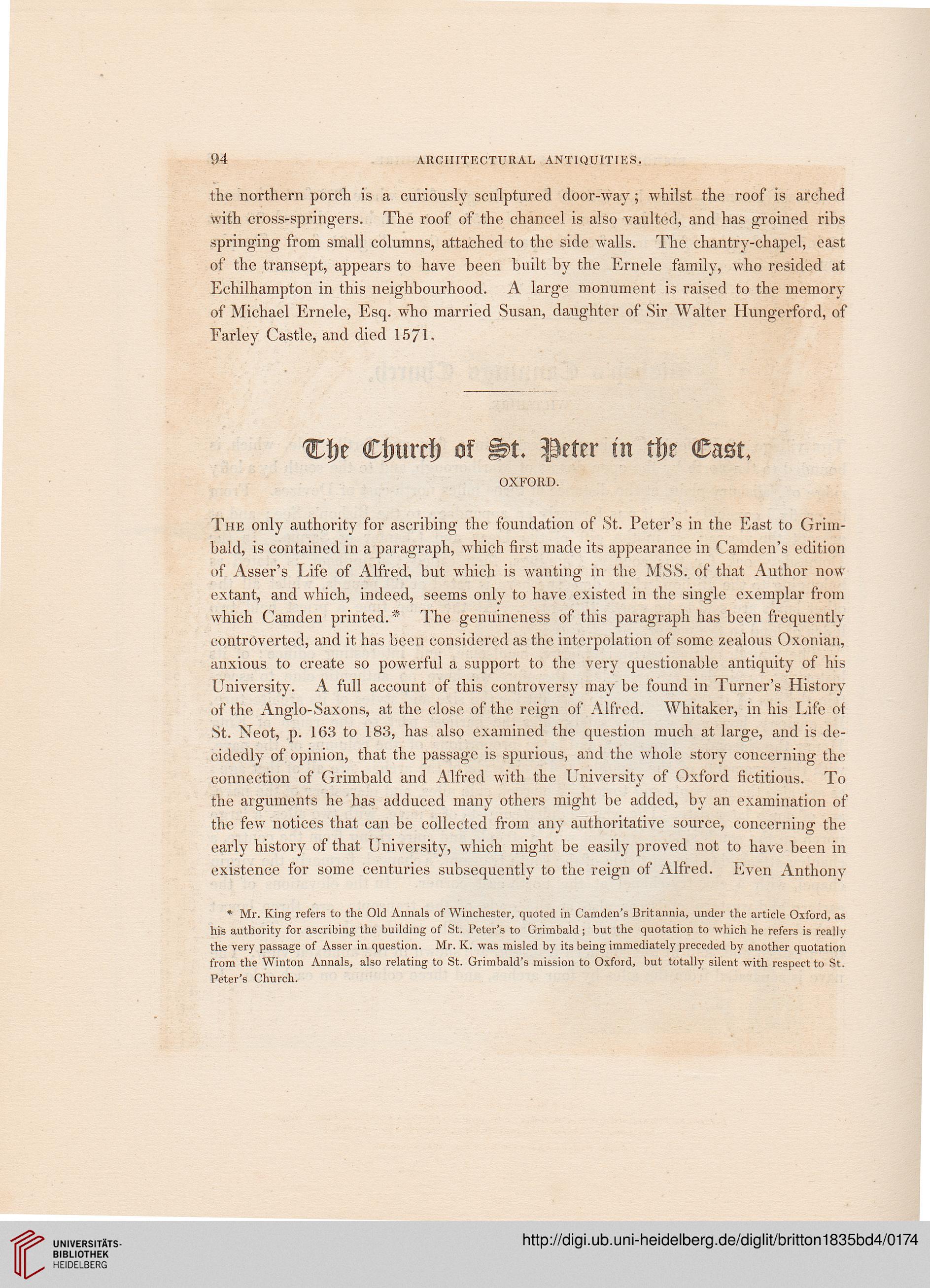94
architectural antiquities.
the northern porch is a curiously sculptured door-way; whilst the roof is arched
with cross-springers. The roof of the chancel is also vaulted, and has groined ribs
springing from small columns, attached to the side Avails. The chantry-chapel, east
of the transept, appears to have been built by the Ernele family, who resided at
Echilhampton in this neighbourhood. A large monument is raised to the memory
of Michael Ernele, Esq. wlio married Susan, daughter of Sir Walter Hungerford, of
Farley Castle, and died 1571.
Cijr Cfmrci) of §>t Peter in tfje Cast,
OXFORD.
The only authority for ascribing the foundation of St. Peter's in the East to Grim-
bald, is contained in a paragraph, which first made its appearance in Camden's edition
of Asser's Life of Alfred, but which is wanting in the MSS. of that Author now
extant, and which, indeed, seems only to have existed in the single exemplar from
which Camden printed.* The genuineness of this paragraph has been frequently
controverted, and it has been considered as the interpolation of some zealous Oxonian,
anxious to create so powerful a support to the very questionable antiquity of his
University. A full account of this controversy may be found in Turner's History
of the Anglo-Saxons, at the close of the reign of Alfred. Whitaker, in his Life ot
St. Neot, p. 163 to 183, has also examined the question much at large, and is de-
cidedly of opinion, that the passage is spurious, and the whole story concerning the
connection of Grimbald and Alfred with the University of Oxford fictitious. To
the arguments he has adduced many others might be added, by an examination of
the few notices that can be collected from any authoritative source, concerning the
early history of that University, which might be easily proved not to have been in
existence for some centuries subsequently to the reign of Alfred. Even Anthony
* Mr. King refers to the Old Annals of Winchester, quoted in Camden's Britannia, under the article Oxford, as
his authority for ascribing the building of St. Peter's to Grimbald; but the quotation to which he refers is really
the very passage of Asser in question. Mr. K. was misled by its being immediately preceded by another quotation
from the Winton Annals, also relating to St. Grimbald's mission to Oxford, but totally silent with respect to St.
Peter's Church.
architectural antiquities.
the northern porch is a curiously sculptured door-way; whilst the roof is arched
with cross-springers. The roof of the chancel is also vaulted, and has groined ribs
springing from small columns, attached to the side Avails. The chantry-chapel, east
of the transept, appears to have been built by the Ernele family, who resided at
Echilhampton in this neighbourhood. A large monument is raised to the memory
of Michael Ernele, Esq. wlio married Susan, daughter of Sir Walter Hungerford, of
Farley Castle, and died 1571.
Cijr Cfmrci) of §>t Peter in tfje Cast,
OXFORD.
The only authority for ascribing the foundation of St. Peter's in the East to Grim-
bald, is contained in a paragraph, which first made its appearance in Camden's edition
of Asser's Life of Alfred, but which is wanting in the MSS. of that Author now
extant, and which, indeed, seems only to have existed in the single exemplar from
which Camden printed.* The genuineness of this paragraph has been frequently
controverted, and it has been considered as the interpolation of some zealous Oxonian,
anxious to create so powerful a support to the very questionable antiquity of his
University. A full account of this controversy may be found in Turner's History
of the Anglo-Saxons, at the close of the reign of Alfred. Whitaker, in his Life ot
St. Neot, p. 163 to 183, has also examined the question much at large, and is de-
cidedly of opinion, that the passage is spurious, and the whole story concerning the
connection of Grimbald and Alfred with the University of Oxford fictitious. To
the arguments he has adduced many others might be added, by an examination of
the few notices that can be collected from any authoritative source, concerning the
early history of that University, which might be easily proved not to have been in
existence for some centuries subsequently to the reign of Alfred. Even Anthony
* Mr. King refers to the Old Annals of Winchester, quoted in Camden's Britannia, under the article Oxford, as
his authority for ascribing the building of St. Peter's to Grimbald; but the quotation to which he refers is really
the very passage of Asser in question. Mr. K. was misled by its being immediately preceded by another quotation
from the Winton Annals, also relating to St. Grimbald's mission to Oxford, but totally silent with respect to St.
Peter's Church.




